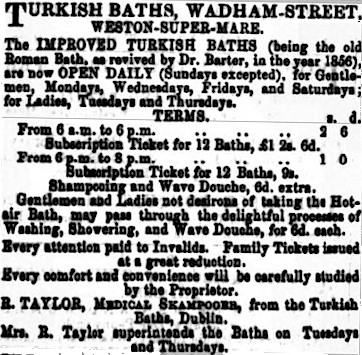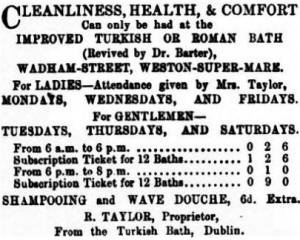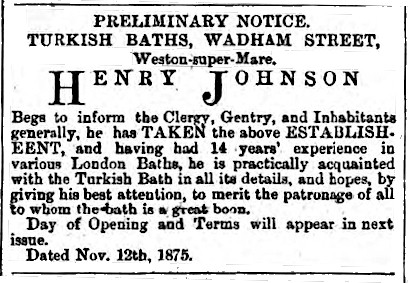Early years
In 1861, barely five years after the first Victorian Turkish bath opened, Richard Taylor returned to Weston-super-Mare from a stay in Dublin. He had been there, according to a local newspaper, 'for the express purpose of making himself acquainted with the working of establishments of this kind', prior to opening one in Weston.
An advertisement in the same issue stated that Taylor was the 'Proprietor, from the Turkish Baths, Dublin,' and that the baths would open on Monday 24 June. He doesn't say which Turkish baths he was at in Dublin, nor whether he actually worked there for a while, or merely paid a visit. But the only Dublin baths that would have impressed potential clients would have been Dr Richard Barter's establishment in Lincoln Place.
This seems to be borne out by an early advertisement placed shortly after the baths opened.

In it, Taylor styles himself as Medical Shampooer and, right at the top of the ad, refers to Dr Barter's Improved Turkish Baths, a phrase which would place himself clearly in the camp of those providing heated dry air, rather than moist air, and referring to the Roman bath rather than a vaporous Islamic hammam. We also learn that, in common with many small Turkish baths, the proprietor's wife becomes manager on women's days.
The Turkish bath facilities themselves are not described or even listed, though the complementary washing and showering facilities are mentioned. However, given Taylor's time in Dublin, it is safe to assume that there is a cooling-room and at least two hot rooms. It is also safe to deduce that the hot rooms are heated by some type of hypocaust because, in a general article on the Turkish bath published five years later, in 1866, the author writes that,
our readers will be pleased to hear that a radiating chamber has just been added to the Turkish Bath establishment in Walham-street, in this town, in which a temperature of 280º of a delightful dry heat may be indulged in by the robust, wishing to render himself proof against the variations of temperature to which our climate exposes us, as well as by the valetudinarian, desirous of recruiting his strength and taking another lease of his mundane existence.
Soon after the baths opened, a letter from Taylor was published in the Gazette explaining very clearly the differences between the Turkish bath and the vapour bath or vapour box. Business seems to have been slow at first, Taylor writing,
I am sorry to find so much prejudice existing in this town with parties that have never given themselves the pleasure of passing through the delightful process of the Turkish bath. If they would avail themselves of taking one, speaking from experience, I am sure they would feel more healthy and vigorous than they ever felt in their whole lives, and would no longer speak against the Turkish bath.
Later in the year, adverts for the baths tentatively mentioned them as 'A Preventative and Cure of Diseases,' a claim not calculated to endear them to the local physicians. Nevertheless a year later Taylor, undaunted, claimed that only the use of the Turkish bath could result in cleanliness and health,

so healthy indeed, that the following year saw the announcement of the birth of a son to Mrs Taylor at the Turkish Baths. Although such births are known to have taken place quite literally within a Turkish bath, it seems most likely that in this instance the baths were being referred to solely as the Taylors' residence.
By now the baths must have been of good repute for in August 1863 they were visited by Major Robert Poore who had, a few months earlier, become a director of the London & Provincial Turkish Baths Co Ltd, owners of the recently opened Jermyn Street Hammam. Poore was a new convert to the Turkish bath and at this time all his visits were recorded in his diary. Unfortunately he does not indicate what he thought of those he visited.
An uncertain picture of the middle years
At this preliminary stage of research into the story of the baths, there are considerable gaps due to the absence of easily available access to local newspapers between 1866 and 1869. What took place between 1866 and 1875 was also affected by whether Richard Taylor actually owned the baths building or whether, in common with most small bath owners, he merely rented the property while owning the baths business.
Be that as it may, it seems that some time after the beginning of May, when the last (so far seen) advertisement proclaiming his ownership of 'Taylor's Celebrated Turkish Baths' appeared, he decided to retire or, perhaps, just sell the business.
So at first glance it is difficult to know how to interpret the Turkish Baths, Wadham Street advertisement published three years later in March 1869. This stated that,
H. KIESER, on his leaving Weston-super-Mare for TORQUAY, wishes to convey his sincerest thanks for the patronage received. At the same time he bids a hearty "good bye" to all his patrons and friends, whom he shall be happy to attend upon at his NEW and IMPROVED TURKISH BATHS, TORQUAY, now nearly finished. where he was offering new and improved Turkish baths.
Had Kieser bought the Weston building, or just the business? The ad makes no mention of whether he was the proprietor of the baths. Perhaps he was just a shampooer who had now decided to start on his own.
Some of the answers are to be found in an advertisement in the Torquay Times published a few months later, in mid July.
In it, Kieser announces the opening of the Torquay Turkish Baths in Warren Road. Over his name he writes, 'The Proprietor having had a similar establishment in Weston S. Mare for several years,' expects to have similar support in his new establishment.
This seems to suggest that Kieser had probably been the proprietor of the Weston baths since the middle of 1866. It would have needed to be around that time for Kieser to be able to refer to his having been the proprietor of the baths 'for several years.'
Whether or not Richard Taylor had originally owned the building, it is reasonable to assume that Kieser had only rented it. It is not possible to tell from the available evidence whether there was a new short-lived proprietor after his departure, or whether the then owner of the building had appointed a similarly short-lived manager. But the baths were certainly closed for a time after Kieser left.
At the end of 1870 there was an announcement in the Gazette informing readers that, 'The Turkish Baths, Wadham Street, will be opened on Monday next, January 2nd, 1871, Under the Superintendence of Mr. R. Taylor.'
It seems that Taylor must have been considered a safe pair of hands to assist the new owner until a permanent manager could be found. Again, due to a current lack of evidence, we cannot tell how long it was before a new manager was appointed. But by January 1874 the position had been filled and was held by a Mr J T Moor (sometimes spelled Moore).
Confirmation of the supposition that Kaiser was not the owner of the baths building is found in the announcement of an auction to be held in September that year. The Turkish baths was one of a dozen freehold properties to be sold by the trustees of the 'estate of the late W. Tucker, Esq, deceased.'
The following week the details of the properties were published, including those of the baths.
Lot 9.—All that MESSUAGE or DWELLING_HOUSE, situated in Wadham-street, Weston-super-Mare aforesaid, known and used as "The Turkish Baths," and now in the occupation of Mr. John Thomas Moor, as yearly tenant.
According to the Mercury, the sale on 22 September went well. 'The company in attendance exceeded 300 persons, and the competition for the several lots was most spirited.' The Turkish baths and premises were bought by a Mr Hurman for £570.
The baths under Henry Johnson
After a few months it became clear that Hurman was going to be a more hands-on proprietor than the previous one. Perhaps he thought the baths were under-performing, and after 'a thorough cleansing and refitting' and connection to the water mains, an advertisement ran for several weeks which showed the new distinction being made between the proprietor and the managers, the latter now including Mrs Moore.

A further series of adverts emphasising 'the most approved Stove,' the 'thorough ventilation,' and 'the excellent town water,' ran in the Mercury from February to April, and on through May. But Hurman was not satisfied with the results.
Nor, by the middle of April, did he seem to have any confidence that things would improve so long as the Moores were the Baths Managers. After owning the baths for only seven months, he set about exploring a number of options.
First, he offered to sell the baths or let them on a long lease. To encourage a sale he offered mortgage facilities for 'a large portion of the purchase money'. Or, to encourage a long lease, he stated that he is 'open to treat with an enterprising man (or company), his object being to make the Establishment a real success, and thus be a boon to the town.'
By the beginning of November Hurman had had enough and the Moores appear to have been dismissed. Possibly because they had been unable to pay their rent, Mr Wansbrough, the local auctioneer, was instructed to sell 'the household furniture & effects of the house. Immediately after which, the baths will be opened under new management.'

During the following three weeks the new manager made his presence known stating, first, that he had taken the establishment, 'having had 14 years' experience in various London baths. Second, he announced that the baths would be re-opened the following week 'after being entirely CLEANSED and RENOVATED.' Third, the baths now being already open again, noted the opening hours and charges.
After the Johnsons settled in, the baths seemed to run more satisfactorily. Certainly there seems to be no further mention of the concerns of Mr Hurman. And the Mercury's List of Residents and Visitors continued to include Mr and Mrs Johnson and family as residents at the baths until the middle of February 1878.
A mystery disappearance, and the final years
This situation came to an unexpected end on some unknown date after 14 February when the names of Mr and Mrs Johnson no longer appeared on the list of residents at the Turkish baths. It seems that the baths must have closed around then also, although no announcement stating this has been found.
We only know of the closure because of an advertisement published on 10 May stating that the Turkish baths would be re-opened the following Monday, 13 May, 'By experienced Managers,' though no managers were actually named. Accompanying the advertisement was an editorial item welcoming their return, 'believing that in their present replete form, they form no inconsiderable part of the attractions of the town.'
Two weeks later it was confirmed that 'The Turkish Baths are now open under experienced management,' but again without naming who the managers were.
The names of the managers would, of course, be familiar to bathers, and the baths appear to have been running normally for the next couple of years. But at the beginning of April 1880, the baths were being offered for sale again, together with a semi-detached villa in Atlantic Road, 'for many years past in the occupation of the owner, W. Hurman, Esq., who is leaving the town.'
Finally, from the sale advertisement, we have an indication of how many rooms the baths had, and we learn who has been the experienced manager for the past few years. Lot 2, we are told, comprises,
All that centrally-situated Freehold PROPERTY, called or known as "The Turkish Baths, 17, Wadham-street," now in the occupation of Mrs Johnson, as weekly tenant thereof, at 24s. per week.
The premises are in good condition, and comprise a large and elegantly-fitted cooling-room, two hot-rooms, shampooing and shower-rooms, w.c., &c., with sitting-rooms, three bedrooms, kitchen and other useful offices. This lot is free from ground rent.
So what had happened to Mr Johnson? In such circumstances it would be usual to assume that he had died, and that the baths were being run by his widow, as was often the case. But if so, there was no notice of his death in the bath adverts, nor has any obituary been found in the local newspapers.
By 3 July, the Mercury was again including Mrs Johnson and family as being resident at the baths; she, and the rest of the family, may never have left, and the earlier Mercury omissions were possibly prompted by their being tactful, not knowing whether Mr Johnson was still there or not.
The same advertisement tells us that the baths were unsold at the April auction, and the following year, the 1881 census tells us that they were being run by Mrs Mary M Johnson with son and daughter. Had Mr Johnson left her?
In January 1882, a private advertisement was placed in the Mercury stating that the Turkish baths were 'To be LET or SOLD, by Private Contract, with immediate possession.' The premises, it suggested, could well be utilised as a private dwelling, and applications should be made 'to owner, W Hurman, Bridgwater.'
Interestingly, between 1861 and at least 1866, a pharmaceutical Chemist by the name of Mr John Hurman owned a Turkish bath in at The Cornhill in Bridgwater, but it is not known whether the two were related.
Mrs Johnson continued to run the Turkish baths with her son and daughter until at least the end of January 1882. But, towards the end of June, the Mercury reported that the baths 'have just been sold by Mr Wansbrough to Mr. Thomas Cogle, of this town.'
By now, Weston-super-Mare Turkish baths had closed, and the town remained without until new ones were opened in Royal Crescent in December 1890, by a Mr. H. Ruck.
Postscript: so what happened to Henry Johnson?
In due course, further research might lead us to find earlier clues as to what happened to Henry Johnson, but so far local newspapers do not refer to him again until August 1888, ten years after he was last recorded as living at the Turkish baths. A rather sad account in the Weston Mercury about his death sketches some of the facts, but not how the story began, nor any of the reasons why he suddenly disappeared. Headed 'Death from alleged imprudent treatment,' the paragraph relates how Johnson,
a masseur known in that capacity to many distinguished Englishmen and Frenchmen, has just died under rather painful circumstances at the Sainte-Anne Asylum. Johnson had been for some time an inmate of that establishment, and a few days ago he became so violent that the "straight waistcoat" had to be applied. While in the hands of the keepers the man died, and blame has been thrown on the officials of the asylum for their imprudent treatment of the deceased. Johnson, who had recently been discharged from the Paris Hammam, will be remembered by many in Weston-super-Mare as the proprietor of the Turkish Baths that for a time flourished in Wadham-street.
Without further information we can only surmise that in 1878 Henry and Mary Johnson decided to separate, perhaps because of occasional violence, or periods of mental instability, or simply due to one of the many other reasons why couples split.
A year earlier, Paris saw the opening of a grand Victorian Turkish baths establishment in Rue des Mathurins.
Widely recognised as being modelled closely on the Jermyn Street Hammam, it was reported that 'two or three Englishmen are employed as shampooers'.
We don't know when Johnson took up his post at the Paris Hammam, but the establishment—wishing to emulate its Jermyn Street model—would clearly have welcomed an experienced English masseur around the time he left home.
